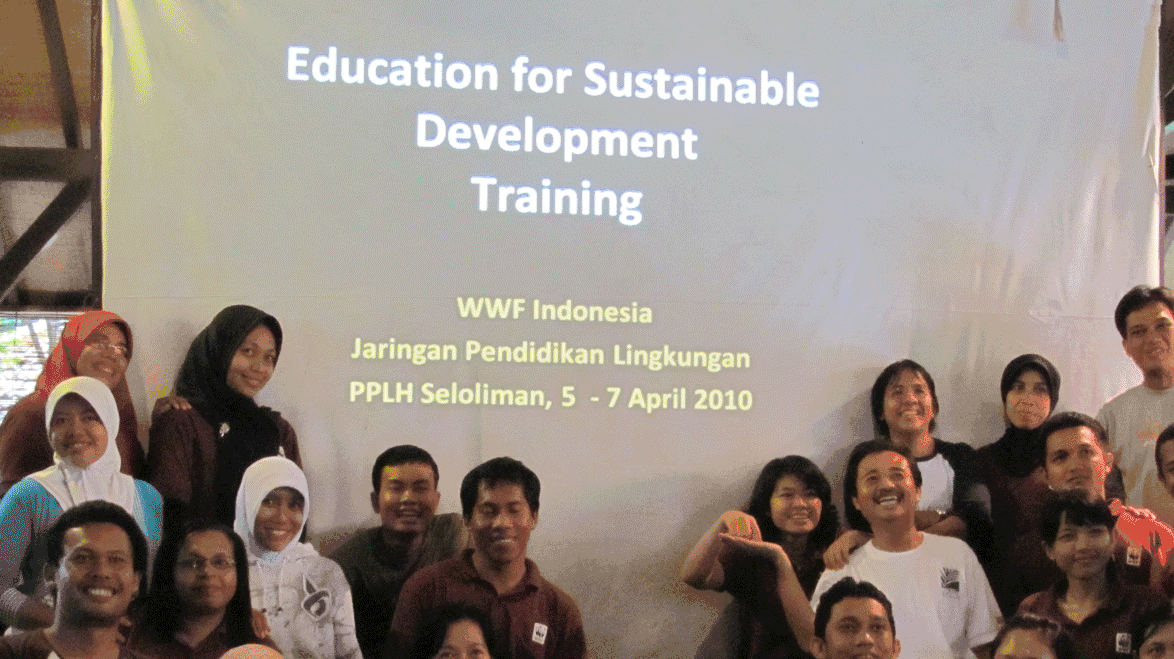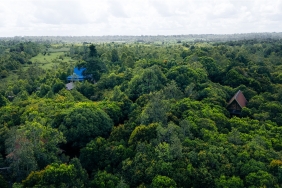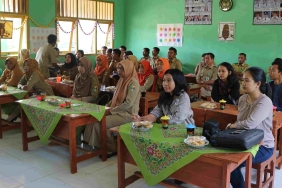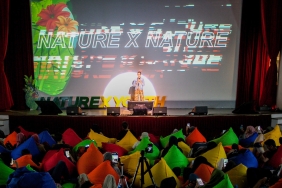LEARNING TO BE A TEACHER FOR EDUCATION FOR SUSTAINABLE DEVELOPMENT IN INDONESIA
The idea of education for sustainable development (ESD) is becoming a favorite in the learning system in Indonesia, which is what I and my friends from Earth Hour and Marine Buddies of Central Java, East Java and Papua regions learned in the Training of Trainers held by WWF-Indonesia.
Located at Omah Yudhi in Temanggung, Central Java, we gained a lot of knowledge about ESD during the 4 days held from January 21-25, 2020. Not only focused on learning about environmental problems that occur in the world, we were also equipped with knowledge about fun learning methods in the teaching/education system.
That Wednesday morning (1/22/2020) was very cool. Accompanied by the morning air and a very beautiful view of Omah Yudhi, I and the other participants started the learning session by observing the surroundings. Mas Yudhi, the owner of the homestay, told us about the history of this relaxing place. Mas Yudhi also took us on a tour of the homestay area while sharing his love for plants and nature. He also explained his technique of planting with used media, such as carpets and blankets combined with the vertical garden technique.
While walking around and listening to Yudhi's story, there were two things that amazed me. First, the aesthetics of the plants that were planted and placed in such a conceptualized way. The second thing that inspired me was the iconic stilt house concept. Yes, Omah Yudhi has the concept of a house on stilts, including the place where I will sleep for the next few nights. Beautiful, simple, yet cozy. If you notice, almost all places in Omah Yudhi also use second-hand goods. Mas Yudhi built this homestay by applying the concept of "back to nature" with a neat and perfect.
After being taken around to explore and observe the surrounding area, we were met by Mr. Pietra. In his session, Mr. Pietra explained what the SDG's are and their 17 goals using card media, so the explanation was very easy to understand. This is a method that I can imitate when I do education to schools later, a way of learning that is fun, light, and makes the educational message well conveyed. He also explained that our critical thinking starts from caring about the environment.
The Sustainable Development Goals (SDG's) are actually an agreement that has been agreed upon as a common goal by 193 countries in the world on September 25, 2015 at the United Nations Headquarters. Indonesia is one of the countries that agreed to the SDG's, where all the goals must be achieved by 2030. Education as one of the fundamental instruments in achieving the SDG's in Indonesia is then translated into ESD, which has begun to be carried out in several schools in Indonesia, but not much.
On this occasion, we met with Mrs. Dewi Partini, the principal of SD Bhayangkara Yogyakarta, one of the schools that has implemented ESD teaching to its students. Mrs. Dewi said, in her school, the implementation of ESD in the curriculum is inserted into local content such as Cultural Arts, Crafts, Technology, and others. She also emphasized that in implementing ESD, the competency given to children is the whole competency, namely recognizing, utilizing, and preserving. This is so that what students learn is not just memorizing in class, but they can understand the essence of the material provided, of course, with fun methods.
After listening to the story of ESD implementation in Java, my friends and I were invited to see how ESD is implemented in Jambi. Mas Lutfie from WWF-Indonesia in Jambi told us that in addition to schools, other parties such as companies, communities, people, and even the government should also apply ESD in their daily lives. Education for sustainable development must involve all parties from all walks of life, to support the achievement of the 17 SDG's in Indonesia.
On the next day, we were met by Mr. Danny who taught us how to use learning methods that can liven up the atmosphere. He also explained the tricks of being a good teacher, how to tell stories and messages that are effective and acceptable to the target audience. I was very happy to receive this material, because these things are very important for me and my friends to run ESD in our respective schools.
Every session given by Mr. Danny was fun, and that's exactly the kind of learning that is expected in today's education. We were taught about designing the session that we will practice the next day in the school that we will visit, starting from opening the learning, inviting them to experience, unraveling the problems they experience, analyzing them, summarizing the learning, up to and closing the learning session.
All Students, All Teachers
We were divided into groups of 4-5 people and given the task of designing a learning session from start to finish. Each group had to design a session with different methods but still had to follow the six processes above. Based on the discussion, we saw that music is a good method of conveying messages. Choosing a singing method and inviting children to create songs is expected to be more easily accepted by children. Not only designing the teaching session, we were also tasked with creating interesting learning tools. We did this session until late at night. Looks tiring? Yes, we were, but the fatigue we felt was outweighed by the excitement and eagerness to meet the children the next day.
Lots of clapping, singing, dancing, and of course new knowledge as we met the children. Their welcoming attitude and curiosity about the activities we would be doing together for the next 3 hours made us very happy.
The overgrown garden of SDN Kandangan made me think of asking them to name all the plants in the school. I found out the names of many plants while walking around the school garden. Not only did I teach these children, but I also gained a lot of knowledge from them. Yes, we learn from each other.
There was one incident that made me believe that these kids are the agents of change for a better environment, when our group explained about the use of tumblr, the reduction of plastic and straws, the environmental impact when they litter, and the rampant poaching. They listened well and nodded their heads in agreement that the environment must be kept in balance, and we were glad they understood that.
In the evening, we discussed again and formulated a follow-up plan to be implemented in our respective cities. This plan also serves as a guideline for us to have a timeline of activities as soon as possible, so that the output or goal of this activity can be realized - the goal of introducing biodiversity and applying ESD to the scope of schools that we will assist.
I feel lucky to be able to participate in this training. From this training, I gained a new perspective on how to teach in the classroom to become a fun learning process. That there are many other media that can be used as learning media outside of books, including utilizing nature and the surrounding environment. Getting to know friends from other regions was also a joy for me, as many new stories from other regions enlivened the learning process.





